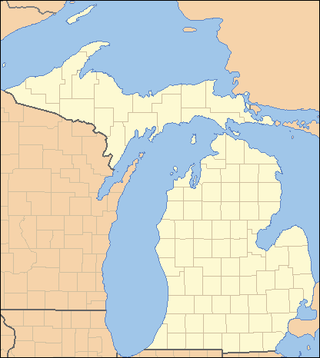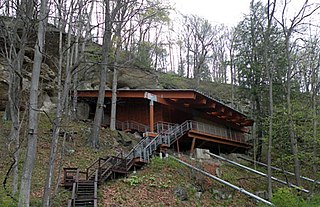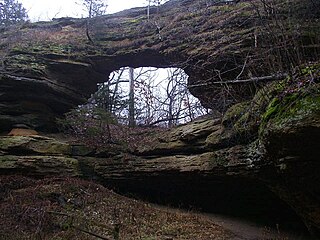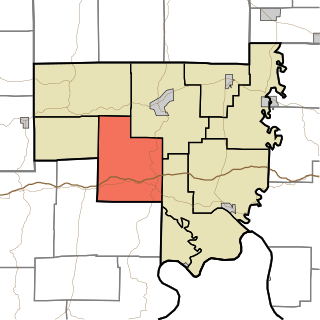
This is a list of properties on the National Register of Historic Places in the U.S. state of Michigan.
This National Park Service list is complete through NPS recent listings posted June 14, 2024.

The Meadowcroft Rockshelter is an archaeological site which is located near Avella in Jefferson Township, Pennsylvania. The site is a rock shelter in a bluff overlooking Cross Creek, and contains evidence that the area may have been continually inhabited for more than 19,000 years. If accurately dated, it would be one of the earliest known sites with evidence of a human presence and continuous human occupation in the New World.

Natural Bridge State Park is a 530-acre (214 ha) state park of Wisconsin, United States, featuring Wisconsin's largest natural arch. Directly beneath the arch is the Raddatz Rockshelter, a rock shelter once used by Paleo-Indians and now listed on the National Register of Historic Places. The park is located southwest of Baraboo between the unincorporated communities of Leland and Denzer, in the town of Honey Creek.

Union Township is one of nine townships in Crawford County, Indiana. As of the 2020 census, its population was 734 and it contained 384 housing units.

Minisink Archeological Site, also known as Minisink Historic District, is an archeological site of 1320 acres located in both Sussex County, New Jersey and Pike County, Pennsylvania. It was part of a region occupied by Munsee-speaking Lenape that extended from southern New York across northern New Jersey to northeastern Pennsylvania. The Munsee were speakers of one of the three major language dialects of the Lenape Native American tribe. This interstate territory became the most important Munsee community for the majority of the 17th and 18th centuries.

The Marmes Rockshelter is an archaeological site first excavated in 1962, near Lyons Ferry Park and the confluence of the Snake and Palouse Rivers, in Franklin County, southeastern Washington. This rockshelter is remarkable in the level of preservation of organic materials, the depth of stratified deposits, and the apparent age of the associated Native American human remains. The site was discovered on the property of Roland Marmes, and was the site of the oldest human remains in North America at that time. In 1966, the site became, along with Chinook Point and the American and English Camps on San Juan Island, the first National Historic Landmarks listed in Washington. In 1969, the site was submerged in water when a levee protecting it from waters rising behind the then newly constructed Lower Monumental Dam, which was 20 miles (32 km) down the Snake River, failed to hold back water that leaked into the protected area through gravel under the soil, creating Lake Herbert G. West.
Barton Village Site, also known as the Herman Barton Indian Village Archeological Site, is a large, multi-component archaeological site near Cumberland in Allegany County, Maryland.

The Rockrimmon Rockshelter is an archeological site in Stamford, Connecticut that was listed on the National Register of Historic Places in 1994. The site is significant as an early Native American shelter and is centered on a boulder about 60 feet high that was used as the shelter. Native American tools and points were discovered at the site during excavations in 1975 and 1980.
The Calpet Rockshelter, also known as the Overlook Rockshelter and Archeological Site 48SU354 is an archeological site in Sublette County, Wyoming. The site includes an overhanging rock outcrop at the base of a butte that was used by Native Americans and European-Americans. The Native American use includes occupation by the Shoshone. A number of surface artifacts have been found and at least two buried cultural levels have been investigated from the Fremont and late Prehistoric-period Shoshone. Fremont, Prehistoric, Protohistoric and Historic-period visitation is documented at nine petroglyph panels.

The LoDaisKa site is a prominent archaeological site in the U.S. state of Colorado, located within a rockshelter near Morrison. The rockshelter was first inhabited by people of the Archaic through the Middle Ceramic period, generally spanning 3000 BC to 1000 AD.
Pawona Witu is an archeological site near Bishop in Inyo County, California that was listed on the National Register of Historic Places in 1975. The listing included 1,080 acres (440 ha). Its location is not disclosed. Archeological sites are often listed on the National Register for their potential to yield knowledge in the future.

The Rockhouse Cliffs Rockshelters are a pair of rockshelters in the far southern region of the U.S. state of Indiana. Located amid broken terrain in the Hoosier National Forest, the shelters may have been inhabited for more than ten thousand years by peoples ranging from the Early Archaic period until the twentieth century. As a result of their extensive occupation and their remote location, they are important and well-preserved archaeological sites and have been named a historic site.

Boone's Mounds are a ceremonial site of the Coles Creek culture located in Calhoun County, Arkansas. The site is one of the largest mound sites in the Ouachita River valley. Archeological excavation at the site has yielded dates of occupation as early as 600 AD, and it may still have been in use during the early contact period, c. 1700. The site was located on private property at the time of its listing on the National Register of Historic Places in 1980.
Skull Creek is a historic archeological site located at Hilton Head Island, Beaufort County, South Carolina. The site includes two of 20 or more prehistoric Indian shell middens in a ring shape located from the central coast of South Carolina to the central coast of Georgia. It probably dates from early in the second millennium BC, and is likely to contain some of the earliest pottery known in North America. The Skull Creek rings are the only known example of a later ring superimposed over an earlier one.
The Talofofo River Valley Site is an archaeological site near Inarajan on the island of Guam. The site's major features include latte stone sets and rockshelters, with radiocarbon dating placing human occupation of the area as early as the first century CE. The site is located in the alluvial plain of the Talofofo River, and was excavated by archaeologist Fred Reinman in 1977.
The Weston Canyon Rock Shelter, located in Franklin County, Idaho in the vicinity of Weston, Idaho is a historic site listed on the National Register of Historic Places in 1974.
The Conley-Greene Rockshelter, also known as site 15EL4, is an archeological site in Elliott County, Kentucky. It was listed on the National Register of Historic Places in 1986.
Dry Creek Rockshelter near Boise, Idaho, is an archaeological site showing periodic use over approximately 3000 years. The site is located under a sandstone overhang, roughly 21 metres (69 ft) wide by 4 metres (13 ft) deep. The rockshelter is unique in that no other local sandstone outcrops are large enough for human habitation. The site was added to the National Register of Historic Places in 1991, and the site address is listed as restricted.















